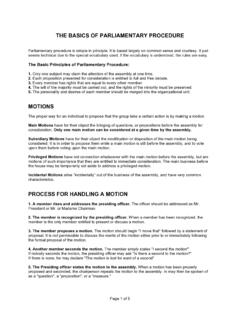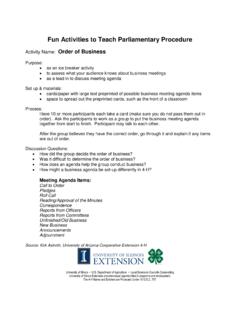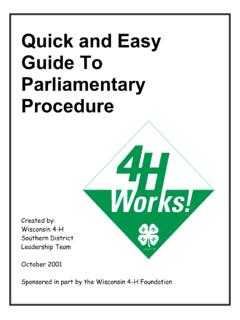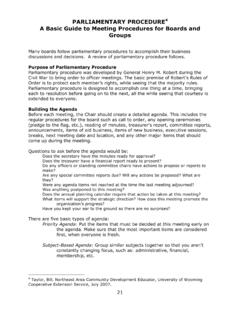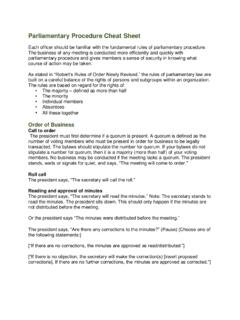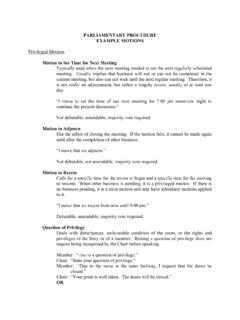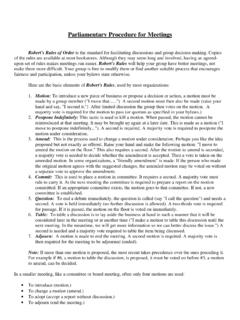Transcription of Simplifi ed Parliamentary Procedure - Training Source
1 Simplifi ed Parliamentary ProcedureExtension toCommunities2 Iowa State University ExtensionIntroductionEffective Meetings Simplifi ed Parliamentary Procedure We must learn to run a meeting without victimizing the audience; but more impor-tantly, without being victimized by individuals who are armed with Parliamentary Procedure and a personal agenda. ~ Procedure . Sound complicated? Controlling? Boring? Intimidating? Why do we need to know all those rules for conducting a meeting? Why can t we just run the meetings however we want to? Who cares if we follow Parliamentary Procedure ? How many times have you attended a meeting that ran on and on and didn t accomplish anything?
2 The meeting jumps from one topic to another without deciding on anything. Group members disrupt the meeting with their own personal agendas. Arguments erupt. A few people make all the decisions and ignore everyone else s opinions. Everyone leaves the meeting feeling frustrated. Sound familiar? Then a little Parliamentary Procedure may just be the thing to turn your unproductive, frustrating meetings into a thing of beauty or at least make them more enjoyable and productive. What is Parliamentary Procedure ? Parliamentary Procedure is a set of well proven rules designed to move business along in a meeting while maintaining order and controlling the communications process. Its purpose is to help groups accomplish their tasks through an orderly, democratic process.
3 Parliamentary Procedure is not intended to inhibit a meeting with unnecessary rules or to prevent people from expressing their opinions. It is intended to facilitate the smooth func-tioning of the meeting and promote cooperation and harmony among rules of Parliamentary Procedure are guidelines, not hard and fast laws. Robert s Rules of Order, the most commonly used system of Parliamentary Procedure , is more than 300 pages. There are many aspects of Parliamentary Procedure which you will never use. Pick and choose what best fi ts the task at hand. This booklet takes a practical approach to Parliamentary Procedure . We relax the rules a little in order to make meetings a little more spontaneous and social.
4 For a stricter inter-pretation of Parliamentary Procedure , you may want to refer to one of the reference books or Web sites listed at the end of this is Parliamentary Procedure Necessary?Formal rules of Procedure usually become more important as groups become larger or more diverse, issues become more controversial or complex, or the stakes involved be-come more signifi cant. Procedural rules should always be seen as a means to an end, not an end in themselves. The important thing is for the group to remain focused on its objec-tives and reach decisions while allowing everyone to participate and be heard. A small group may be able to work effectively without any formal rules if no one tries to dominate the meeting and members treat each other s viewpoints with ed Parliamentary Procedure 3 Principals of Parliamentary ProcedureParliamentary Procedure is based upon a few simple principles: Only one issue can be discussed at a time.
5 All members have equal and basic rights the right to vote, the right to be heard, and the right to oppose. The rights of the minority must be protected. No member can speak until recognized by the chairperson. Every member can speak to the issue on the fl oor; however, no one can speak a second time as long as another wants to speak a fi rst time. A majority vote decides an issue. The chairperson is strictly ChairpersonThe chairperson has the success or failure of the meeting riding on his or her shoulders. He or she should be thoroughly familiar with all the business to be dealt with at the meeting, including committee reports and business held over from previous meetings.
6 The chairperson must be sensitive to the physical, informational, and social needs of the the rules of Parliamentary Procedure , the chairperson has absolute control over the meeting. No one can speak without being recognized by the chairperson. This power comes with a great deal of responsibility. The chair must at all times conduct the meeting impartially and stay on top of the agenda. She or he must be familiar with Parliamentary Procedure in order to keep the discussion moving and know when to take a vote without someone having to call for the question. 4 Iowa State University ExtensionAgendaOrder of Business The AgendaThe chair is usually responsible for preparing the agenda (the items of business to be dis-cussed) and distributing it to the members well in advance of the meeting.
7 The members have the responsibility to propose agenda items to the chair before the meeting. The exact details and order of the agenda should be decided by the group. The following is a typical to OrderRoll Call (if appropriate)Adoption of the AgendaApproval of Minutes from Previous MeetingReports of Offi cers (listed)Reports of Committees (listed)Unfi nished Business (listed)New Business (listed)Announcements (listed)AdjournmentCall to Order: The chairperson begins the meeting at the published time by saying some-thing such as The meeting will now come to order. Roll Call: Roll call is a legal requirement for some local government boards and commis-sions. The minutes must list the names of those present and absent.
8 Some boards and commis-sions have taken the additional step of indicating in the minutes the time late members arrive (it helps get people there on time!). The meeting secretary usually conducts the role call. Civic organizations and community groups may not need to record members present by taking roll of the Agenda: It is a good practice to send members a copy of the tentative agenda in advance of the meeting so they can prepare for the meeting. If this is not possible, the tentative agenda should be given to the members when they arrive at the meeting. A meet-ing without an agenda usually ends up as no meeting at all! Many offi cial government bodies are required to publicize their agendas by informing the news media and posting agendas in a public place prior to the meeting.
9 Government bodies should never add potentially controversial items to the agenda after it is the meeting starts, the chairperson should ask if anyone has items to place on the agenda. After these have been added, the chair should call for a motion to adopt the agenda. A member should, Move that the agenda be adopted. A second is required. A simple majority vote restricts the business of the meeting to the items listed on the agenda. After the agenda has been adopted, it takes a two-thirds majority vote to change formal community groups don t need to formally adopt the agenda. If an agenda is ap-proved by majority vote, however, it can only be changed by a formal motion to do so.
10 This prevents members from introducing new business without prior of Minutes from Previous Meeting: Reading meeting minutes during the meeting is a time waster. Minutes should be sent out (with the agenda) for members to read prior to the meeting. Unless there is a disagreement regarding the minutes, it is not nec-essary for a motion or a vote to accept the minutes. The chairperson can simply declare them approved. Are there any additions or corrections to the minutes? If there are no corrections, the chairperson can say, There being no corrections to the minutes of (date) meeting, the minutes are approved as printed ( or .. approved as amended ). Simplifi ed Parliamentary Procedure 5 Reports of Offi cers: Typically the offi cers will make brief reports on the group s business that has transpired since the last meeting.

